9.1 Introduction – Muhammad
Legend traces the Arabs back to Isma‘il, the son of Abraham and his Egyptian maid, Hagar, a link that would later help to legitimize Islam by connecting it to the Hebrew tradition. Muhammad (c.570 – 632) was born in the city of Mecca.
Muhammad’s father, ‘Abdallah, was a member of the Hashimite Clan, a less prosperous branch of the Quraysh Tribe. ‘Abdullah died just prior to his son’s birth, and Muhammad’s mother passed away when he was just six years old. Orphaned at such a young age, his tribe intervened to ensure Muhammad’s survival. His uncle, Abu Thalib, the leader of the Hashimite Clan and an important member of the Quraysh Tribe, eventually took custody of the young boy. These early privations influenced Muhammad’s later desire to take care of those who could not care for themselves.
In his youth, Muhammad found employment in the regional caravan trade as a dependable herder and driver of camels. During this period, he cultivated a reputation of an empathetic and honest man, one who earned the respect of many Meccans. His upright character soon attracted the attention of a wealthy merchant known as Khadija who hired Muhammad to manage her caravans. Once Muhammad proved his reliability, Khadija, who was fifteen years older than Muhammad, proposed to him, and they married. He spent 15 years happily married and she gave him three sons who all died in infancy, and four daughters. This marriage afforded Muhammad a financial security that allowed him to begin meditating on religion in the abstract. Image 9.1 shows Muhammad and his wife Khadija performing the first wudu, which is the ritual washing that prepares a Muslim for rituals and prayers.

Muhammad had been concerned about the direction society had recently been taking and that some of the most influential members of society, namely the merchant elite of the Quraysh Tribe, were no longer respecting their traditional responsibilities to the weaker members of society because of their own greed. He thought that the People of the Book, specifically, Christians and Jews, might have a better answer for the ills afflicting Meccan society. Muhammad had contact with the Christians and Jews of the peninsula and even traveled to Christian Syria while working in the caravan trade. In this context, the Angel Gabriel appeared to Muhammad at a cave near Mecca in 610, during the holy month of Ramadan. The Angel Gabriel instructed him to “recite,” and then he spoke the divine word of God. His revelations became the Quran. See image 9.2 for a depiction of this event. This image is in a folio from Herat, Afghanistan that is now in the Metropolitan Museum in New York. The language around the image is Farsi. Notice that this shows the face of the Prophet, while the previous image, 9.1, has the Prophet’s face covered. The prohibition against depicting a living being in the arts was followed more in some times and cultures than others, so you will see some images of Muhammad that use only his name written rather than his picture.


At first, Muhammad distrusted the apparition of the Angel Gabriel and he expressed embarrassment because he did not want to be associated with the pagan diviners of the region. Fortunately, his wife Khadija had a cousin who was a hanif, someone who was neither a Christian nor a Jew, but who believed in a vague concept of a monotheistic god. Her cousin trusted the veracity of Muhammad’s revelations. So with trepidation, Muhammad eventually accepted his role as God’s vehicle. His wife became the first convert to Islam.
According to tradition, Muhammad took a Night Journey to heaven on Buraq, a creature that transported prophets to visit heaven. One night about 10 years after he began to prophecy he was resting at the Kaaba. The story says that the angel Gabriel appeared to Muhammad and brought him Buraq which carried him to the Temple in Jerusalem. He prayed there and then mounted Buraq again and flew to heaven where he met with prophets of the Old Testament and Jesus. The Islamic tradition says that while in heaven God gave him instructions about how to be a faithful believer. See images 9.4 and 9.5 for different versions of this story.


Muhammad began preaching to a small circle of friends and went to the Kaaba where Meccans prayed to 360 idols cut from stone in human form, some dressed in costumes and perfumed with spices. He told the people to abandon their idols and adore the one God. The powerful Qurarshite tribe and many others opposed his preaching because it deviated from traditional customs.

The prophet and his followers left Mecca for Medina, a small center for farmers and artisans 270 miles northeast of Mecca with a mixed Arab and Jewish population. In September of 622 he was the last to leave Mecca. His departure is called hegira or flight and 622 CE is the starting point of the Islamic calendar which is based on 12 lunar months or 345 days. In a Christian century there are 103 Mohammedan years.
In Medina Muhammad hoped he would find friends. Three of the eleven principle tribes in Medina were Jewish and he approached them to be his first converts. However they thought he was a false prophet and a political menace trying to usurp the power they shared with the Arabs. He found himself fighting a two pronged war against the Jews of Medina and the Meccans. He became a general to lead his followers into battle. Islam is the only one of the world’s great religions to have been founded on the sword as well as the word. Muhammad expelled the three Jewish clans by force. The first was allowed to leave with their belongings; the second was expelled without their belongings as he destroyed their palm groves. The males of the third group were beheaded and their women and children sold into slavery. Muhammad began raiding parties against the Meccans and stopped camel caravans headed for Mecca. He had a miraculous victory at Badr which his followers believed proved that he was a prophet. This was followed by a crushing defeat at Uhud. Revelation said that the defeat was to test the believers. Muhammad eventually negotiated a treaty with the Quraishites who now recognized him as a legitimate political and religious leader. With an army of 10,000 he marched on Mecca and they capitulated.
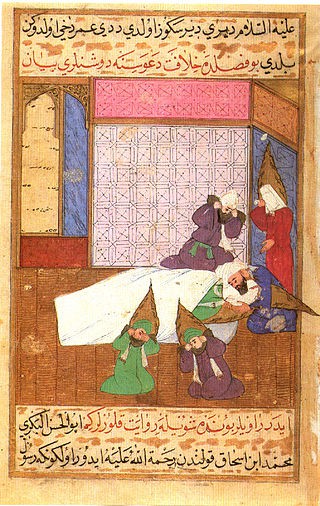
By the time Muhammad died in 632 he had met his immediate goals. The Moslem faith, once a persecuted minority, was now a state religion. He had created a powerful army to enforce his ideas. He was strong enough and wealthy enough to pursue a policy of conquest. He said he had received a revelation that all idolaters should be converted by force if necessary. This included Jews and Christians which were called “people of the book.” Muhammad is viewed by Muslims as the last in a succession of prophets who preached parts of the same message. Their earlier sacred writings, the Torah, the Psalms of the Old Testament, and the Gospel of Jesus are constantly mentioned in the Quran. These people were given special protection under Muslim law. Jesus is granted particular respect by Muslims. When Muhammad died an election was held, and Abu-Bakr (r. 632 – 634) established the first caliphate.
Abu-Bakr set about to consolidate control of Arabia, and Muslim expansion began in Syria, Palestine, Iraq, Egypt, and Persia. Perhaps no single historical event between the fall of Rome and the European voyages of discovery was more important than the rise of Islam. Expansion continues into North Africa, and the Mediterranean. In 652 the Quran and the oral teachings of Muhammad were put into writing. Its final written form was not complete until 935. Debate continues to rage over which parts of the Quran are his words and which are the words of his followers.
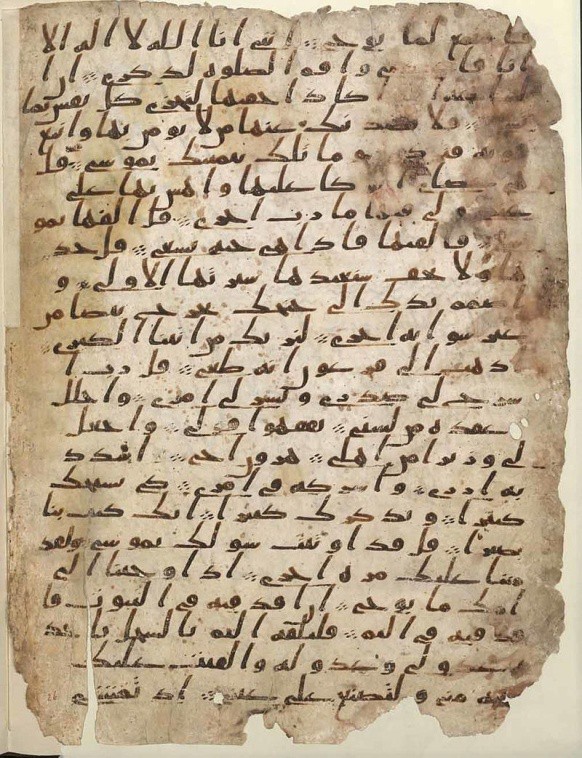
In 656 there was a growing split in the Muslim community. Abu Bakr had been Muhammad’s closest friend, and his election brought much-needed stability and an almost democratic form of government to Islam. As caliph, Abu Bakr held together the converts to Islam by deploying the forces at his disposal, thus cementing his authority among the Arabian tribes. He prevented any rebellious Muslim tribes from reverting to the worship of their traditional tribal gods. Abu Bakr died in 634, two years after the Prophet Muhammad died.
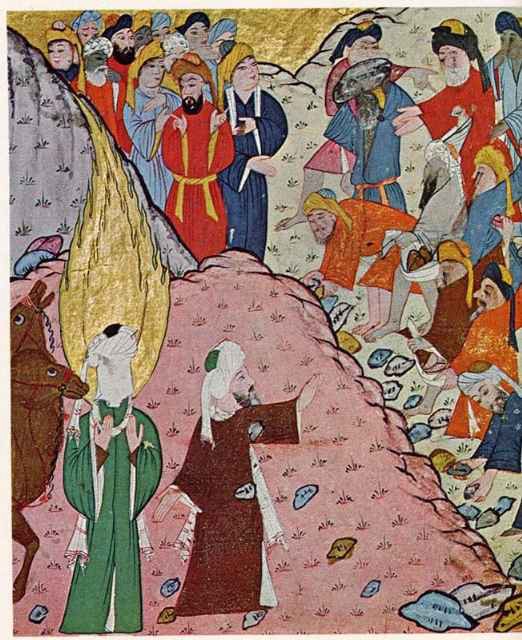
The next caliph was ‘Umar Ibn Al-Khattab (586 – 684), a close friend of Abu Bakr. ‘Umar had been the military power behind Abu Bakr. A dynamic and uncompromising leader, ‘Umar recognized the necessity of expansion northward to achieve various ends. First, he sought to subdue the security threat of raiding nomads, many of which remained a law unto themselves. Second, in his struggle to contain discontent, he used the cohesive element of jihad to unite the Muslim community against unbelievers. The Arabic term of jihad actually refers to a “struggle,” usually against spiritual impurity, often known as “greater jihad,” and is associated with fulfilling God’s objectives here on earth. The “lesser jihad,” alternatively, is a physical struggle against the unbelievers of the Dar al-Harb, or Abode of War, until it is absorbed into the Dar al-Islam, or Abode of Islam, where believers were free to practice their faith as members of the predominant faith. Of note is the fact that Muhammad did not consider jihad important enough to make it one of the pillars of Islam. Third, ‘Umar understood the importance of plunder for the nascent caliphate. Troops received four-fifths of the loot from conquest; the remainder of the revenue went to him to be dispersed amongst the neediest members in the Islamic community. ‘Umar directed the full might of Islam northward against the Eastern Roman Empire, sometimes referred to as the Byzantine Empire.
‘Umar directed his forces against the Byzantines at Palestine in 634. The ensuing Battle of Ajnadayn was a decisive victory for the Muslims and a major loss for Emperor Heraclius. Two years later, an outnumbered Muslim army defeated the Eastern Roman Empire yet again at the Battle of Yarmouk, located on the Eponymous River, somewhere between Damascus and Jerusalem. In both instances, the Byzantines relied on their slow, heavy cavalry, whereas the Arabs capitalized on their light armor and their superior mobility. The Muslims realized that they could not just charge the East Roman lines; they showed their tactical superiority by flanking the Byzantines and executing a successful rearguard action instead. These victories opened up greater Syria to Muslim conquest. Antioch, Aleppo, and Jerusalem fell to the Muslims not long thereafter.
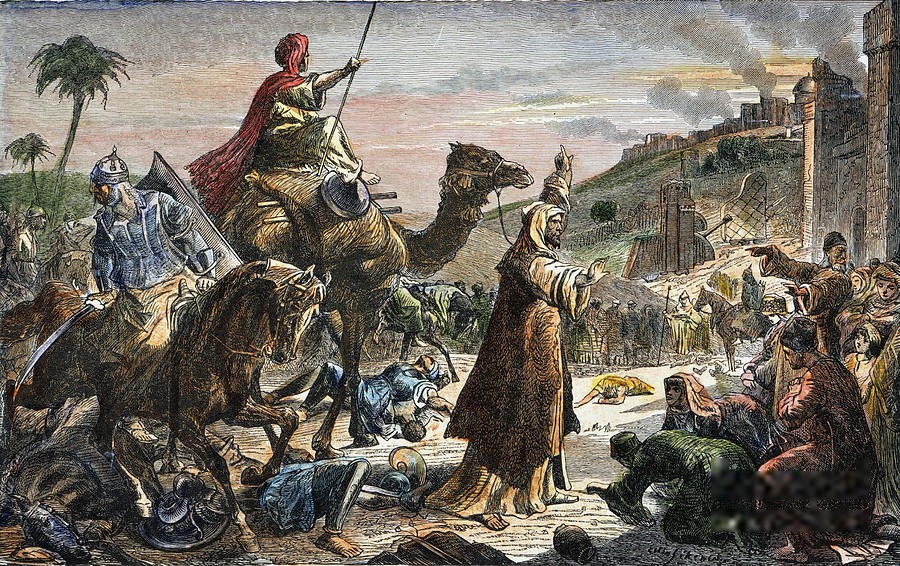
Once he dealt with the increasingly vulnerable Byzantines, ‘Umar directed his army to the east against the Sasanian Empire of Persia. In 636, fighting along the banks of the Euphrates River, a smaller Arab force triumphed over the Persians, at the Battle of Qadisiya. After successive days of exhaustive combat, the Muslims took advantage of environmental conditions and their light cavalry’s mobility when they chased a dust storm and took the Sasanids by surprise. In 642, Umar’s army eventually defeated the forces of the Sasanian Emperor Yazdagird III at the Battle of Nahavand, situated deep in Iran’s Zagros Mountains.

Clearly outnumbered Muslim armies thus successfully defeated two long-standing empires in the span of just a few decades. Several explanations help us understand the rapid expansion of Islam during this period. One concept, termed the vacuum theory, posits that the Byzantine and Persian empires had been severely weakened from near-continuous fighting, dating back decades prior to the rise of Islam, so they both suffered from the fatigue of war. Islam, therefore, occupied the vacuum of political power resulting from the collapse of these two exhausted empires.
The success of Muslim military strategy offers a second explanation. While Byzantine forces adopted a defensive stance on the battlefield, the Arabs employed more aggressive tactics, making use of their mobile light cavalry against their enemies’ heavily armored armies. Once victorious, the Arabs populated garrison cities on the frontier, called amsar, with Muslims. These military settlements provided security, served as logistical loci, and discouraged Muslim troops from mingling with the locals. The caliphs thereby prevented their warriors being assimilated into the communities of the conquered while also preventing soldiers from disturbing the peace. The Muslims further exploited the internal divisions of targeted societies, as exemplified in Egypt, where the Coptic Christian majority, together with a large Jewish minority in Alexandria, had suffered under the rule of an oppressive Greek Orthodox Christian minority but gained autonomy and toleration within an Islamic state. In Syria, another Christian minority called the Syrian Orthodox Church, or Jacobites, collaborated with the Muslims and hastened the collapse of the Byzantines. All these factors led the early Islamic state to expand exponentially.
Uthman succeeded as the 3rd caliph when Umar died, but he was killed in a mutiny because he had ordered a complete revision of the Quran. The 4th caliph was Ali, who was the son-in-law of Muhammad and husband of his daughter Fatima. This appointment was not accepted by all factions and war broke out. Two years later he was killed. The Shi’a mourned his death and today they consider him a saint because they believe he should have been the successor. The Sunnis accept Ali and the first three caliphates as the rightful leaders. Should a literal descendant of Muhammad or a selected leader be caliph? There was no clear method to determine the line of succession. There were problems with favoritism, anger, and fighting in the dominant families. In 659 Muslims divided into Shia, Sunni and Khariji sects and there has been open conflict between the Sunni and the Shia since then.
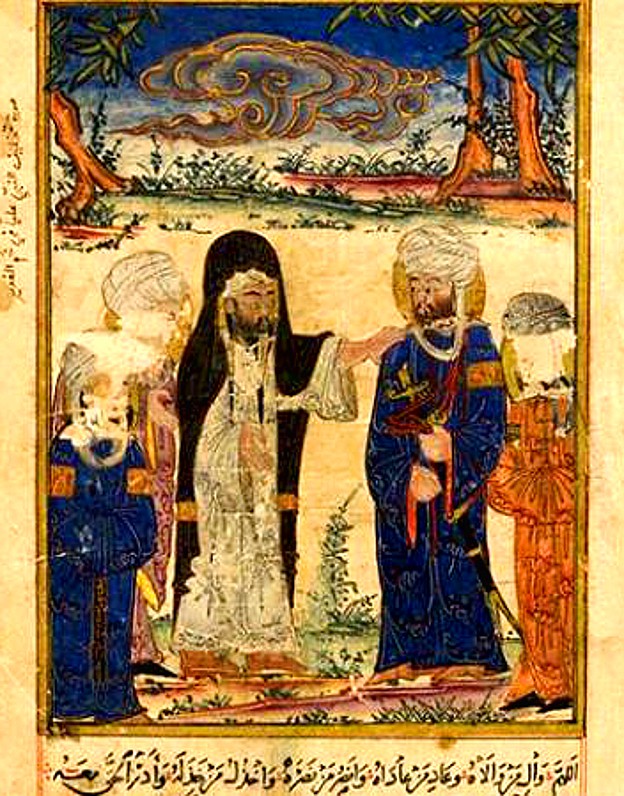
There are many YouTube videos that discuss Islam. Some are more radical than others. The following are links to some of the more educational and shorter videos that might help you understand Islam for the purposes of this class.
You might like this 10 minute overview of Islamic culture.
If you have difficulty viewing the video above, use this link: https://www.youtube.com/watch?v=Gg6ju-lHCwU&list=PL87g_-g-EKUDmJTOQOtvheK1h7XxCcnHY.
Or watch this 10 minute “History of Islamic Iran” to see how the Islamic Iran changed hands multiple times.
If you have difficulty viewing the video above, use this link: https://www.youtube.com/watch?v=h_9wHKCxoZg.
You might also like this 12 minute video by the Khan Academy that shows the Spread of Islam.
If you have difficulty viewing the video above, use this link: https://www.youtube.com/watch?v=ojSkGvxFi4M&list=PL87g_-g-EKUDmJTOQOtvheK1h7XxCcnHY&index=5.
Or maybe this 10 minute “History of Islam” a quick 10 minute history of Muhammad and the beginnings of Islam.
If you have difficulty viewing the video above, use this link: https://www.youtube.com/watch?v=4NT_btkLlho.
Attribution:
Berger, Eugene; Israel, George; Miller, Charlotte; Parkinson, Brian; Reeves, Andrew; and Williams, Nadejda, “World History: Cultures, States, and Societies to 1500” (2016). History Open Textbooks.
References:
1. Lutfi Abdullah, Public domain. https://commons.wikimedia.org/wiki/File:Siyer-i_Nebi_-_Muhammad_und_ Chadidscha_ ()_f%C3%BChren_die_ersten_rituelle_Waschung_-wudhu-_durch.jpg
2. Metropolitan Museum of Art, Public domain. https://commons.wikimedia.org/wiki/File:Muhammad-Majmac-al-tawarikh-1.jpg
3. By Salat-Ahmad2099, CC BY 2.5. https://commons.wikimedia.org/wiki/File:Muhammad_Salat.PNG
4. Public domain. https://commons.wikimedia.org/wiki/File:Miraj_by_Sultan_Muhammad.jpg
5. Sultan Muhammad Nur, CC0. https://commons.wikimedia.org/wiki/File:% 22The_Mi%27raj_or_The _Night_Flight_of_ Muhammad_on_his_Steed_Buraq%22,_Folio_3v_from_a_Bustan_of_Sa%60di_MET_h1_1974.294.2.jpg
6. Photo by 5ieme Nathan, Public domain. https://commons.wikimedia.org/wiki/File:Muhammad_destroying_idols_-_L%27Histoire_Merveilleuse_en_Vers_de_Mahomet_BNF.jpg
7. Public domain. https://commons.wikimedia.org/wiki/File:Siyer-i_Nebi_414a.jpg
8. Public domain. https://commons.wikimedia.org/wiki/File:Birmingham_Quran_manuscript_folio_2_verso.jpg
9. Public domain. https://commons.wikimedia.org/wiki/File:Abu_Bakr_stops_Meccan_Mob.jpg
10. By Granger, Public domain. https://commons.wikimedia.org/wiki/File:The_entrance_of_Caliph_Umar_(581%3F- 644)_into_Jerusalem,_638-_colored_engraving,_19th_century..jpg
11. Public domain. https://commons.wikimedia.org/wiki/File:Age_of_Caliphs.png
12. Public domain. https://commons.wikimedia.org/wiki/File:Investiture_of_Ali_Edinburgh_codex.jpg

